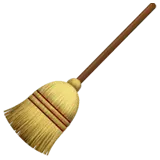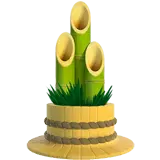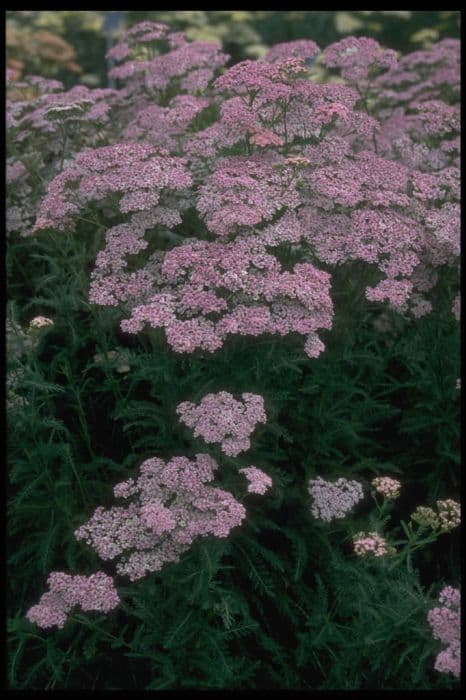Yarrow Achillea 'Martina'

ABOUT
Achillea 'Martina', commonly known as yarrow, is a perennial flowering plant that is appreciated for its ornamental and herbaceous qualities. It features a dense cluster of fern-like aromatic foliage, which has a soft, feathery texture. The leaves are typically green, sometimes with a hint of greyish or silvery tones, giving them a somewhat muted yet soothing appearance. The most striking aspect of yarrow is its flowers. Achillea 'Martina' produces an array of small, tightly packed blooms that form flat-topped clusters, known as corymbs or umbels. These flowers bloom in a soft pastel shade, often lavender to pale violet, creating a delicate and whimsical look. These blossom clusters stand upright, presenting themselves boldly above the foliage, and they generally bloom during the late spring through summer months. The plant's overall appearance is that of a traditional cottage garden specimen, providing a relaxed and unstructured aspect to garden designs. Yarrow is commonly used in borders, as ground cover, and it's also a popular choice for wildflower gardens, where its appearance can attract beneficial insects and pollinators such as bees and butterflies. Its feathery leaves and dense flower heads give it a texture that can add depth and contrast when planted alongside other garden plants.
About this plant
 Names
NamesFamily
Asteraceae
Synonyms
Martina Yarrow
Common names
Achillea 'Martina'.
 Toxicity
ToxicityTo humans
Yarrow (Achillea 'Martina') is not considered highly toxic to humans. However, like many plants, it can cause adverse reactions in some individuals, especially if ingested in large quantities or if someone has a specific allergy to it. Ingestion can lead to gastrointestinal discomfort, such as diarrhea or vomiting. It is always recommended to exercise caution and avoid eating any plant parts unless they are known to be safe for consumption.
To pets
Yarrow (Achillea 'Martina') is also not considered highly toxic to pets, but it can cause mild gastrointestinal upset in some animals if ingested. Symptoms might include vomiting, diarrhea, drooling, or an upset stomach. While not typically life-threatening, monitoring your pet and consulting a veterinarian if symptoms appear is advisable to ensure their well-being.
 Characteristics
CharacteristicsLife cycle
Perennials
Foliage type
Deciduous
Color of leaves
Green
Flower color
Mixed
Height
2 feet [60 cm]
Spread
2 feet [60 cm]
Plant type
Herb
Hardiness zones
3
Native area
Europe
Benefits
 General Benefits
General Benefits- Attracts pollinators: Achillea 'Martina' is known to attract beneficial insects such as bees and butterflies, which are essential for pollination.
- Drought resistance: Once established, this plant is quite drought-tolerant, making it suitable for xeriscaping and low-water gardens.
- Low maintenance: It typically requires minimal care, making it a great choice for gardeners who prefer low-maintenance plants.
- Long blooming period: Achillea 'Martina' often has a prolonged flowering season, providing color in the garden throughout summer and sometimes into fall.
- Cut flowers: The flowers of this plant are excellent for cutting and creating bouquets, maintaining their color and form for several days.
- Resilience to pests and diseases: Achillea 'Martina' is generally resistant to many common garden pests and diseases.
- Soil adaptability: It can adapt to a range of soil types, although it prefers well-drained soil.
 Medical Properties
Medical PropertiesThis plant is not used for medical purposes.
 Air-purifying Qualities
Air-purifying QualitiesThis plant is not specifically known for air purifying qualities.
 Other Uses
Other Uses- Dye Production: Achillea 'Martina', commonly referred to as Yarrow, can be used to produce varying shades of yellow-to-green dyes for textiles, depending on the mordant used.
- Companion Planting: Yarrow attracts beneficial insects such as ladybugs and hoverflies, which help to control pest populations in the garden.
- Fertilizer: The leaves of Yarrow are rich in minerals and can be used as a fertilizer; when added to compost, they can accelerate the decomposition process.
- Floral Arrangements: With its attractive flowers, Yarrow can be used fresh or dried in floral arrangements, adding texture and variety to bouquets.
- Natural Mulch: Yarrow can be cut and left on the ground as a natural mulch, which helps retain moisture, suppress weeds, and gradually enrich the soil.
- Erosion Control: Due to its network of roots, Yarrow can be planted on slopes or areas prone to erosion to help stabilize the soil.
- Wildlife Habitat: Yarrow provides food and habitat for various insects and birds, supporting local biodiversity.
- Decorative Craft Material: Dried Yarrow flowers and stems can be used in decorative crafts, such as wreath making, owing to their durability and aesthetic appeal.
- Traditional Games: Historically, the stems of Yarrow have been used for divination and casting lots in various cultural traditions.
- Landscape Design: Yarrow is often used in xeriscaping, which utilizes drought-resistant plants to create sustainable and low-maintenance landscapes.
Interesting Facts
 Feng Shui
Feng ShuiThe Yarrow is not used in Feng Shui practice.
 Zodiac Sign Compitability
Zodiac Sign CompitabilityThe Yarrow is not used in astrology practice.
 Plant Symbolism
Plant Symbolism- Healing: Named after the Greek hero Achilles who used yarrow (Achillea) to treat wounds, symbolizing healing and restoration.
- Courage and protection: In folklore, yarrow was used as a protective charm and to instill courage in warriors.
- Love and attraction: Achillea was sometimes used in love spells and is thought to attract love when worn or carried.
- Divination: Historically, yarrow stalks were used for I Ching divination, symbolizing the power to reveal hidden knowledge.
- Friendship: The plant is associated with creating and maintaining lasting bonds, symbolizing lasting relationships.
 Water
WaterYarrow 'Martina' prefers soil that is well-drained and can tolerate some dryness, but it's important to establish a regular watering schedule. As a general guideline, water the plant deeply about once a week, providing about one to two inches of water each time. During the hotter, dryer months, monitoring the soil moisture is crucial, and additional water may be required if the top inch of soil becomes dry. It's better to avoid frequent, shallow watering which can lead to weak root development. Overwatering or allowing the yarrow to sit in soggy soil can increase the risk of root rot, so ensure that the soil has good drainage.
 Light
LightYarrow 'Martina' thrives in full sun, meaning it requires at least 6 to 8 hours of direct sunlight daily. The best spot for this plant is in an area of the garden that is exposed to unfiltered sunlight for the majority of the day. Partial shade is acceptable, especially in extremely hot climates, but too much shade can lead to leggy growth and fewer blooms.
 Temperature
TemperatureYarrow 'Martina' is hardy and can tolerate a wide temperature range, withstanding temperatures as low as -30°F to -20°F in winter. It grows best in temperatures between 65°F and 75°F. The ideal temperature conditions for robust growth and flowering are moderate to warm daytime temperatures followed by cooler nights.
 Pruning
PruningPrune Yarrow 'Martina' to maintain plant health, shape, and to encourage more blooms. Deadheading spent flowers will promote further blooming throughout the season. In late fall or early spring, cut back the entire plant to about 6 inches to prepare it for new growth and to keep it from becoming too leggy. The best time for a more extensive prune is just before new growth starts in the spring.
 Cleaning
CleaningAs needed
 Soil
SoilYarrow 'Martina' thrives in well-draining soil with a pH range of 5.5 to 7.0. A mix of garden soil, compost, and coarse sand or perlite is ideal to ensure proper drainage and nutrient balance.
 Repotting
RepottingYarrow 'Martina' typically does not require frequent repotting and can be done every 2-3 years or when the plant outgrows its container.
 Humidity & Misting
Humidity & MistingYarrow 'Martina' is tolerant of a wide range of humidity levels and does well in average outdoor conditions without needing specific humidity adjustments.
 Suitable locations
Suitable locationsIndoor
Ensure full sun and well-draining soil for Yarrow 'Martina'.
Outdoor
Plant Yarrow 'Martina' in full sun with well-draining soil.
Hardiness zone
3-9 USDA
 Life cycle
Life cycleThe life of Achillea 'Martina', commonly known as yarrow 'Martina', begins with seed germination, typically occurring in early spring, where the seed requires light to germinate and should be sown on the surface of well-drained soil. Following germination, the seedling stage involves the development of the first true leaves, and the plant begins to establish its root system. Vernalization, exposure to cooler temperatures, may be necessary for some yarrow plants to stimulate flowering. As the plant enters the vegetative stage, it forms a clump of fern-like foliage and the stems elongate. The reproductive stage is marked by the plant producing flat-topped clusters of pink flowers, which attract a variety of pollinators during the late spring or summer. Finally, after flowering, the plant sets seeds which disperse for the next generation, and the above-ground parts of the plant may die back in the winter, with the root system surviving to regrow the following spring.
 Propogation
PropogationPropogation time
Early Spring
Achillea 'Martina', commonly known as Yarrow 'Martina', is generally propagated through division during the spring or early fall. For division, the gardener would carefully dig up the parent plant, making sure to get a generous amount of roots. Next, they would gently tease apart or cut through the root ball to separate the plant into smaller clumps, each with its own section of roots and shoots. These clumps are immediately replanted into the garden or into pots with well-draining soil, watered thoroughly, and provided with ample sunlight. The divisions should establish themselves quickly, benefiting from the mature root system and the cooler, moist conditions of these seasons which promote root growth and reduce stress on the newly planted divisions.









